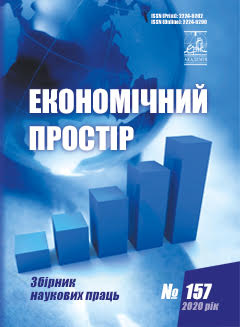THEORETICAL MODELS OF ANALYSIS OF ECOLOGICAL AND ECONOMIC DEVELOPMENT
Abstract
The article deals with the currently important problem of the influence of the effects of economic development on the environment. The purpose of the article is to analyze the impact of these effects, to develop an integrated model of ecological and economic development, which is based on the generalization of the already studied approaches and a broader presentation of information on the parameters of sustainable development. The object of research is the processes that help to achieve sustainable development. For the methodological support of the research, the created theoretical model of the analysis of ecological and economic development was used. The model allows determining the possibilities of achieving the Environmental Kuznets Curve (EKC). In order to take into account the processes of accumulation and absorption of various greenhouse gases in the atmosphere, an approach to estimation the accumulated amount of carbon dioxide (CO2) in the atmosphere was proposed in the form of an integrated model. This model takes into account oceanic and biospheric absorption of hydrocarbon emissions from human activities. The article defines the ways to achieve the Environmental Kuznets Curve (EKC) as a condition for achieving sustainable development. It was found that a sufficient condition, which should ensure the absence of deterioration of sustainable development, is the transition through the point of maximum level of environmental pollution. This point describes emissions of pollution, taking into account the effect of accumulation of environmental pollution, which begins to manifest itself after exceeding the assimilation capabilities of nature. At the same time, during economic recovery, the impact of losses from carbon dioxide (CO2) emissions is not as noticeable as during economic recessions. Therefore, overcoming the constant increase in pollution concentration will require a significant increase in the environmental efficiency of the economy and coordination of actions between countries in the long term. Based on this, the practical significance of the article lies in finding new ways to achieve sustainable development.
References
Ruttan V.W. (1971). Technology and the Environment. American Journal of Agricultural Economics, vol. 53, no 5, pp. 707–717.
Antle J.M., Heidebrink G. (1995). Environment and Development: Theory and International Evidence. Economic Development and Cultural Change, vol. 43, no 3, pp. 603–625.
Grossman G.M., Krueger A.B. (1991). Environmental Impacts of a North American Free Trade Agreement. National Bureau of Economic Research, no 3914, pp. 1–39.
World Bank (1992). World Development Report 1992: Development and the Environment. Oxford University Press, New York.
Stokey N.L. (1998). Are There Limits to Growth? International Economic Review, vol. 39, no 1, pp. 1–31.
Dasgupta S., Laplante B., Wang H., Wheeler D. (2002). Confronting the Environmental Kuznets Curve. Journal of Economic Perspectives, vol. 16, no 1, pp. 147–168.
Li H., Berrens R.P., Grijalva Th. (2007). Economic Growth and Environmental Quality: a Meta-analysis of Environmental Kuznets Curve Studies. Economics Bulletin, vol. 17, no 5, pp. 1–11.
De Bruyn S.M., Van Den Bergh J.C.J.M., Opschoor J.B. (1995). Empirical Investigations in Environmental-Economic Relationships Reconsidering the Empirical Basis of Environmental Kuznets Curves and the De-linking of Pollution from Economic Growth. Tinbergen Institute Discussion Paper, Amsterdam.
Siegenthaler U. (1983). Uptake of Excess CO2 by an Outcrop-diffusion Model of the Ocean. Journal of Geophysical Research: Oceans, vol. 88, no. C6, pp. 3599–3608.



